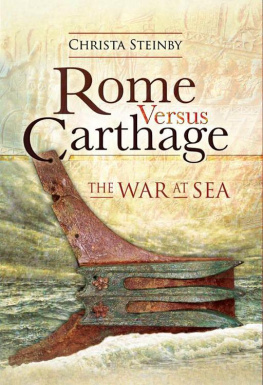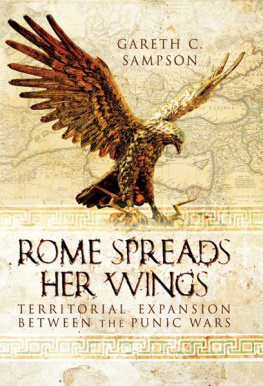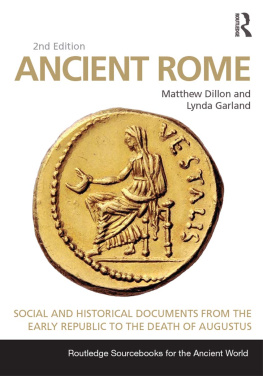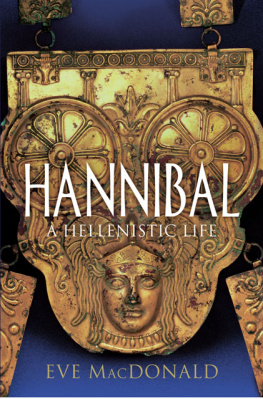Rome versus Carthage
The War at Sea
Christa Steinby

First published in Great Britain in 2014 by
Pen & Sword Maritime
an imprint of
Pen & Sword Books Ltd
47 Church Street
Barnsley
South Yorkshire
S70 2AS
Copyright Christa Steinby 2014
ISBN 978 1 84415 919 2
The right of Christa Steinby to be identified as the Author of this Work has been asserted by her in accordance with the Copyright, Designs and Patents Act 1988.
A CIP catalogue record for this book is available from the British Library.
All rights reserved. No part of this book may be reproduced or transmitted in any form or by any means, electronic or mechanical including photocopying, recording or by any information storage and retrieval system, without permission from the Publisher in writing.
Typeset in Ehrhardt by
Mac Style Ltd, Bridlington, East Yorkshire
Printed and bound in the UK by CPI Group (UK) Ltd, Croydon,
CR0 4YY
Pen & Sword Books Ltd incorporates the imprints of Pen & Sword Archaeology, Atlas, Aviation, Battleground, Discovery, Family History, History, Maritime, Military, Naval, Politics, Railways, Select, Transport, True Crime, and Fiction, Frontline Books, Leo Cooper, Praetorian Press, Seaforth Publishing and Wharncliffe.
For a complete list of Pen & Sword titles please contact
PEN & SWORD BOOKS LIMITED
47 Church Street, Barnsley, South Yorkshire, S70 2AS, England
E-mail:
Website: www.pen-and-sword.co.uk
Contents
M y thanks to Pascal Arnaud, David Blackman, Paavo Castrn, William Harris, Chris Howgego, Jonathan Prag, Boris Rankov, Damian Robinson, Philip de Souza, Sebastiano Tusa and Johan hlfeldt for support and advice. Part of the work was conducted in the excellent research conditions provided by St Benets Hall and the Faculty of Classics, at the University of Oxford. The writing of this book was funded by the Ella and Georg Ehrnrooth foundation and the editing process was supported by the Gerda Henkel Stiftung. I am grateful for their support. My thanks to Vincent Gabrielsen and the SAXO-institute at the University of Copenhagen.
Coins in the plate section are being printed by the permission of MnzkabinettStaatliche Museen zu Berlin and The Trustees of the British Museum. My thanks to Sebastiano Tusa for the photo of the Egadi ram and the permission to use it.
My thanks to Rupert Harding and everyone at Pen and Sword. The manuscript was finished at the end of 2011; except for few exceptions no later publications have been added. Any omissions or mistakes are naturally mine.
Turku 16.7.2014
Christa Steinby
For a detailed view of the Ancient Mediterranean, see the digital map by Johan hlfeldt http://imperium.ahlfeldt.se
Maps
Map 1. The Western Mediterranean during the Punic Wars.
Map 2. Fleets in the Second Punic War (previously published in Ancient Society 34 (2004) and Steinby, The Roman Republican Navy, Commentationes Humanarum Litterarum 123. Reprinted with the publishers permission).
Plates
1. Carthaginian silver tetradrachm dated to 330300 BC. Tanit/Horsess head. MnzkabinettStaatliche Museen zu Berlin, 18206042.
2. Roman aes signatum, or struck bronze bar used in early Roman coinage. Anchor/Tripod. MnzkabinettStaatliche Museen zu Berlin, 18202537. Crawford, Roman Republican Coinage (RRC) 10,1.
3. Ram of a Roman warship (Egadi 1) This is the first of the rams discovered at the Egadi Islands. Photo Sebastiano Tusa.
4. Reproduction of Columna Rostrata C. Duilii for the victory at Mylae in 260 BC. Museo della civilt romana, Rome. (Wikipedia Commons)
5. Roman bronze triens from 225217 BC. Minerva/ Prow. MnzkabinettStaatliche Museen zu Berlin, 18200933. RRC 35,3.
6. Roman as, minted after 211 BC. Janus/Prow. MnzkabinettStaatliche Museen zu Berlin, 18201126. RRC 56,2.
7. Syracusan silver litra from 274216 BC. Hiero II/Quadriga. MnzkabinettStaatliche Museen zu Berlin, 18203196.
8. Carthaginian Shekel from Spain, dated either to Hasdrubals reign (228221 BC) or generally to the period 237209 BC. Barcid ruler/Prow. The Trustees of the British Museum. Sylloge Nummorum Graecorum. SNGuk_0902_0091.
9. Silver denar from 125 BC. Roma/Elephants. MnzkabinettStaatliche Museen zu Berlin, 18201354. RRC 269,1.
10. Bronze coin minted in Etruria, 3rd centrury BC. Head of an African/Elephant. MnzkabinettStaatliche Museen zu Berlin, 18220398.

Map 1: The Western Mediterranean during the Punic Wars.

Map 2: Fleets in the Second Punic War (previously published in Ancient Society 34 (2004) and Steinby, The Roman Republican Navy, CommentationesHumanarum Litterarum, 123. Reprinted with the publishers permission).
Introduction
T he Punic Wars are a crucial period of ancient history. Rome and Carthage fought three wars that permanently changed the balance of power in the Mediterranean. Everyone is familiar with the outcome of these wars: that Carthage was sacked at the end of the Third Punic War in 146 and that Rome became a world power with Pax Romana and Mare Nostrum.
However, at that time, none of this could be taken for granted. The First Punic War (264241) was the first armed conflict in which Rome operated outside Italy, challenging the Punic fleet for the control of Sicily and other islands in the western Mediterranean. The Romans had the initiative and forced the Carthaginians into an arms race by constantly building new fleets a competition in which the Carthaginians could not keep up and thus had to give up Sicily. The contest for thalassocracy continued in the Second Punic War (218201), which did develop into a serious maritime conflict and which Carthage actually lost at sea. It can be seen as the world war of its time: battles took place everywhere in the western Mediterranean, and during this war Rome also became irretrievably involved in the matters of the eastern Mediterranean. At the end of the war, Rome ruled over the western Mediterranean; the Carthaginian fleet was reduced to ten warships and a new era began in RomanCarthaginian relations the Carthaginians paid indemnities to Rome for the next fifty years and were also obliged to send ships and grain, thus participating in the Roman war effort against the Macedonian and Seleucid kingdoms. The Third Punic War (149146) demonstrated the overwhelming power of the Romans and brings to an end a period in which the Romans had conquered all their enemies at sea, both in the west and in the east.
The year 146 thus marks the end of this story. It begins, however, many centuries before the Punic Wars. One of the objectives of this book is to demonstrate that it was not a case of the agrarian Rome vs. the seafaring Carthage, as has sometimes been presented, but the maritime history of both Rome and Carthage has its roots in the centuries preceding the wars, as do the causes that lead to the conflict. Rome and Carthage owe many of their characteristics to the Phoenician and Greek colonies founded from the ninth and eighth centuries onwards that brought trade, new wealth and new connections to the western Mediterranean. This is obviously the case with Carthage, which was founded by Tyrian settlers and gradually became the leading colony of the Phoenicians. Fifth-century Carthage was, alongside Syracuse and Athens, one of the largest states of its time in terms of wealth, power and maritime connections. Rome, on the other hand, was one of the cities on the Tyrrhenian coast where life was changed by the coming of the colonists trade and interaction with the colonies made Rome an important and prosperous city. In the centuries before the Punic Wars, the Romans operated at sea as did any other nation in the Tyrrhenian. Consequently, in the Punic Wars, there were two seafaring nations competing for power over the western Mediterranean.










